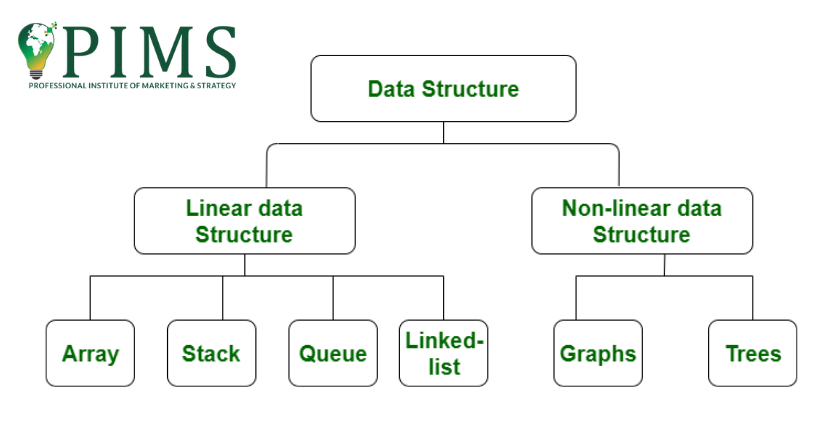What you should know about Data Structure?
Whether you are new to programming or an experienced programmer, you would have heard about data structures. Understanding data structures types is important if you want to be a qualified programmer or have programs that can perform basic operations. It’s well-known that programs are algorithms and data structures.
Data structures are complex, and it is essential to understand what is data structure and why they are important in Data Science. This knowledge will be helpful whether you’re preparing for interviews or building a foundation for your coding education. You must understand about it.
What is Data Structure?
In computer science, a data structure is a system that stores data, organizes it, and allows for easy modification & access. A data structure is simply a collection of data values and their relationships. It also includes the operations or functions that can be performed on them. Keeping it simple:
- Programs = algorithms + data structures
- Data Structures = related data + allowed operations on that data
Solid data structures are the foundation of efficient and effective programs, and data structures are probably the most fundamental building block subject in a data science course in India.
What is the Importance of Data Structure?
Data structures are the foundation for any computer program. It isn’t easy to create an efficient program without the correct data structure. Computer programs depend on data. If you want to create a smoothly running program, getting the data structure right is vital. Data structures that logically organize data and allow easy access to, modification, and configuration are key to a program’s success.
What are the Classifications of Data Structures?

What is data structure? Good question! There are so many characteristics and definitions that it is easy to become confused. As we have seen, there are many types and classifications for data structures and data. The sheer volume of information raises more questions. What is a linked list? What is a linear data structure? What is data structure?
Let’s look at the classifications to help us understand data structures. There are three major data structure classifications that are taught in the Data Science course in Noida, and each one consists of a pair of characteristics.
Linear and nonlinear data structure
Linear structures organize data in a linear order, such as an array, list, or queue. Nonlinear structures don’t form a series but connect to multiple information items such as a graph or tree.
Dynamic and Static
As the name implies, Static structures are fixed, permanent structures that can be compiled at compile-time. The array stores a predetermined amount of memory that the programmer has set up. Dynamic structures have non-fixed memory capacities that can shrink or expand according to the program’s execution needs. The location of associated memory can also change.
Both Homogenous & Non-Homogenous.
Homogenous data structures comprise the same type of data elements, such as element collections in an array. Non-homogeneous data structures don’t require the same data type as structures.
Types of Data Structure
We have already covered data structure classifications. We will continue our walk through the various data structure elements by looking at different types of data structures which you will learn in the best data science course in Noida from PIMS.
Array
Arrays contain data items of the same type and are stored in adjacent memory locations. An “element” is a data item stored in a single location. Arrays are the most fundamental, basic data structure. Data Scientists who are interested in becoming Data Science experts need to master array construction before moving on to other structures like queues and stacks.
Graphs
Graphs are nonlinear pictorial representations of element sets. Graphs are composed of finite node-set, also known as vertices, and linked by links, which are called edges. Trees are another variation of graphs. However, there are no rules for how nodes connect.
Hash Tables
This structure is usually built using arrays, and hash tables convert keys into values. A unique number is assigned to every book in a library, which allows you to look up information such as who checked it out and its availability. Each book in the library is hashed to a unique number.
Linked List
Linked lists are linearly arranged to store item collections. A linked list stores item collections in linear order. Each element contains a data item and a link or reference to the next item.
Stack
Stacks store items in a linear ordering and can apply operations. The order can be either “first in, first out” (FIFO) or “last in and first out” (LIFO span>).
Queue
Queues are linear lists that store items sequentially, much like stacks. However, the order of operation must be “first in first out.” Queues can be described as linear lists.
Tree
Trees are used to store item collections in an abstract hierarchy. These multilevel data structures use nodes. The “leaf nodes” are the bottom nodes, and the “root node” is the topmost node. Each node contains pointers that point at adjacent nodes.
Trie
Not to be confused with Trees, Tries are data structures that store strings as data items and are displayed in visual graphs. Tries can also be called keyword trees, prefix trees, or keyword trees. When you search for something and get autosuggestions from it, you witness the trie data structures in action.
Do you know about algorithms?
An algorithm is a step-by-step procedure that specifies the steps to be followed to achieve the desired output. Algorithms can be created independently of the underlying languages, and an algorithm can be implemented in multiple programming languages.
The following are important algorithms from a data structure perspective –
- Search – Algorithm for searching an item within a data structure
- Sort – An algorithm to order items in a particular order.
- Insert – Algorithm to insert a record in a data structure.
- Update – Algorithm to modify an item in a data structure
- Delete – An algorithm to remove an item from a data structure.
Stack in Data Structures
Stack is an abstract data type with a predefined capacity. It’s a simple data structure that allows you to add and remove elements in a specific order. Each element is added to the top of the stack, and only the element at the top can be removed, just like a pile.
An Array or a linked list can easily create a stack. Arrays can be implemented quickly, but they are small in size. Linked Lists require overhead to allocate, link, unlink and deallocate. However, it is not very large.
Career opportunities in Data Science
These are the most popular job titles and career options after doing a Data Science course in India:
Business Intelligence Analyst
Business intelligence analysts analyze data to identify market and business trends and develop a better picture of the company’s position.
Data Mining Engineer
Data mining engineers examine data from their business and information obtained from third parties. A data mining engineer can also analyze data and create advanced algorithms to explore it further.
Data Architect
Data architects work closely with developers, users, and system designers to create blueprints for data management systems that centralize, integrate, and maintain data sources.
Data Scientist
Data scientists start by translating a business plan into an analytics agenda. They then develop hypotheses & understand data, and then they look for patterns to determine how these patterns will impact businesses. Data scientists also choose algorithms to analyze the data further. Data scientists use business analytics to explain the impact of the data on a company’s future and help companies devise solutions to these problems.
Senior Data Scientist
Senior data scientists can predict the future needs of a company. They collect data and analyze it thoroughly to solve complex business problems. They have the experience not only to create but also to drive new standards.
Top 10 interview questions for the data scientist?
Q. What’s data science?
A. Data science is the discipline that analyzes, organizes and uncovers data to make informed decisions. Industries and companies accumulate large amounts of data and use it in multiple ways to find the best ways to improve business processes.
Q. Why is deep learning better than machine learning?
A. Machine Learning does not improve accuracy as data grows in size, the algorithms become saturated with more data, and the weights don’t change as expected. Deep Learning is better for large datasets, and it uses the Neural Network to give a higher accuracy slope. It can also be used in non-structured data such as images and texts.
Q. Why convert categorical features to numerical features? What are the best techniques to accomplish this?
A. Machines can’t understand categorical variables, and we need to make machines understand variables and their values from the dataset. To do this, we can use label encoding or one-hot encoding.
Q.Why are activation functions necessary?
A. Activation functions convert the output from a separate model layer to a more readable, constant form so that subsequent layers can read it.
Best Data Science Institute in Noida
PIMS is a top Data Science Institute for industry-relevant training and certifications in data science courses. With a variety of carefully curated courses for students of all experiences, PIMS has led thousands of hopefuls to dream positions in data engineering, digital marketing, and data science, in addition to data analytics.
You can select a data science course in Noida with classroom facilities or select a data science course in Noida via online classes. Start your journey towards an effective career change in an upward direction.
The team comprises highly effective trainers with extensive industry experience and a passion for creating an industry-ready and highly employable youth ready for future challenges.
Being the most prestigious institute for data science located in Noida, PIMS ensures a complete value-driven experience for students. The focus on students and job-oriented education in data science, individualized mentorship, constant curriculum revision to meet industry standards, and a broad range of classes make them the most prestigious institute for data science in India.


